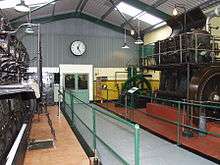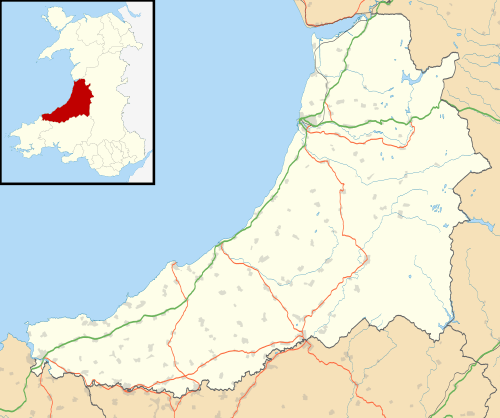Internal Fire – Museum of Power
The Internal Fire – Museum of Power is a museum of internal combustion engines in West Wales. The museum's collection is mostly of larger stationary diesel engines, as used for generating sets and pumping stations. The museum is located at Tan-y-groes, Ceredigion, near Cardigan.
 View into Hall 1 | |
 Location within Ceredigion | |
| Location | Tan-y-groes, Ceredigion, Wales |
|---|---|
| Coordinates | 52.11987°N 4.49122°W |
| Type | Technology museum |
| Website | Internal Fire – Museum of Power |
Exhibits

Most of the engines are restored to working order. Each day, a range of engines will be in operation during the museum's opening. On special occasions, at Easter and the second weekend in October, an attempt is made to run as many of the engines as possible.
Diesel
The museum operates the oldest working diesel engine in the UK, a 1912, Sulzer single cylinder, Air-blast injection Diesel, an example of the original Rudolf Diesel design.
Steam
The museum houses over 200 tons of working engines in nine Halls and is in the process of creating a new Steam Hall which will house a 1903, J & E Wood, 500hp tandem compound along with an 1879, John Penn, twin cylinder oscillating paddle steamer (ex Empress) as well as a number of smaller engines including the only surviving Petter steam engine.
In 2017, the museum's second Engineering Heritage Award exhibit[lower-roman 1] arrived.[1] A 1901, 140 bhp three cylinder Willans engine generating set had been used until 1957 at the Maples furniture shop in London. On retirement this had been placed on display at the original Willans factory in Rugby[2][3]
Gas turbine
One of the museum's most unusual exhibits is a 'Pocket Power Station', powered by a Bristol Proteus gas turbine engine.[4][5] The regional electricity board installed several 2.7MW, remote-operated, generation sets for peak load powered by the Proteus. Designed to run for ten years many were still in use forty years later.[6] In 2010 this was recognised with an Engineering Heritage Award.[7]
See also
- Anson Engine Museum
- Prickwillow Museum
- Museum of Power, in the former Southend Waterworks, Essex
References
- After the Pocket Power Station
- "Victorian engine built in Rugby leaves for restoration in Wales". Rugby Advertiser. 20 June 2017.
- "Engineering Heritage Awards" (PDF) (5th ed.). Institution of Mechanical Engineers (IMechE). p. 47.
- "Central Valve Steam Engine". Institution of Mechanical Engineers (IMechE).
- South Western Electricity Historical Society. "SWEB's Pocket Power Stations". Internal Fire – Museum of Power. Archived from the original on 2009-01-18.
- "Pocket Power Station". A History of the World. BBC.
- "Pocket Power Station wins award". BBC Mid Wales. 11 June 2010.
- "Engineering Heritage Awards" (PDF) (5th ed.). Institution of Mechanical Engineers (IMechE). p. 10.
